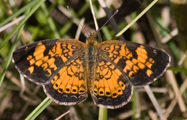Native Plants
Search for native plants by scientific name, common name or family. If you are not sure what you are looking for, try the Combination Search or our Recommended Species lists.
Symphyotrichum laeve var. laeve
Symphyotrichum laeve (L.) Á. Löve & D. Löve var. laeve
Smooth Blue Aster, Smooth Aster
Asteraceae (Aster Family)
Synonym(s): Aster falcidens, Aster laevis, Aster laevis var. falcatus, Aster steeleorum
USDA Symbol: SYLAL3
USDA Native Status: L48 (N), CAN (N)
The stout, leafy stem of this perennial grows 2-4 ft., with dark-green foliage that is smooth on top and rough underneath. The attractive and numerous pale-lavender flowers with yellow centers occur in large, open heads atop the stems.
Variety laeve occurs in the eastern part of the range of S. laeve; there are three other varieties.
Plant Characteristics
Duration: PerennialHabit: Herb
Size Notes: Up to about 4 feet tall.
Leaf: Green
Fruit: Fruit is a cypsela (pl. cypselae). Though technically incorrect, the fruit is often referred to as an achene.
Bloom Information
Bloom Color: Yellow , Blue , PurpleBloom Time: Jul , Aug , Sep , Oct
Distribution
USA: AL , AR , CT , DC , DE , GA , IA , IL , IN , KS , KY , LA , MA , MD , ME , MI , MN , MO , MS , NC , NE , NH , NJ , NY , OH , OK , PA , RI , SC , TN , VA , VT , WI , WVCanada: AB , BC , MB , NB , NL , NS , ON , QC , SK
Native Distribution: ME to Yukon, s. to GA, LA, SD, NM, UT, n. ID & n.e. OR
Native Habitat: Open woods; dry to mesic prairies
Growing Conditions
Water Use: MediumLight Requirement: Sun
Soil Moisture: Dry
CaCO3 Tolerance: Medium
Soil Description: Variable.
Benefit
Use Wildlife: Birds.Conspicuous Flowers: yes
Fragrant Flowers: yes
Attracts: Birds , Butterflies
Larval Host: Pearl Crescent (Phyciodes tharos)
Value to Beneficial Insects
Special Value to Native BeesThis information was provided by the Pollinator Program at The Xerces Society for Invertebrate Conservation.
Butterflies and Moths of North America (BAMONA)
|
Pearl Crescent (Phyciodes tharos)  Larval Host |
Propagation
Description: Sow seeds, 5/8" deep, outside in fall or provide cold stratification. Also propagated by "softwood" cuttings taken in late spring or by separating strong, outer rhizomes from large clumps.Commercially Avail: yes
From the National Organizations Directory
According to the species list provided by Affiliate Organizations, this plant is on display at the following locations:Native Plant Center at Westchester Community College, The - Valhalla, NY
Bibliography
Bibref 1186 - Field Guide to Moths of Eastern North America (2005) Covell, C.V., Jr.Bibref 1185 - Field Guide to Western Butterflies (Peterson Field Guides) (1999) Opler, P.A. and A.B. Wright
Bibref 946 - Gardening with Prairie Plants: How to Create Beautiful Native Landscapes (2002) Wasowski, Sally
Search More Titles in Bibliography
Web Reference
Webref 38 - Flora of North America (2019) Missouri Botanical Garden, St. Louis, MO & Harvard University Herbaria, Cambridge, MA.Additional resources
USDA: Find Symphyotrichum laeve var. laeve in USDA PlantsFNA: Find Symphyotrichum laeve var. laeve in the Flora of North America (if available)
Google: Search Google for Symphyotrichum laeve var. laeve
Metadata
Record Modified: 2023-01-20Research By: TWC Staff